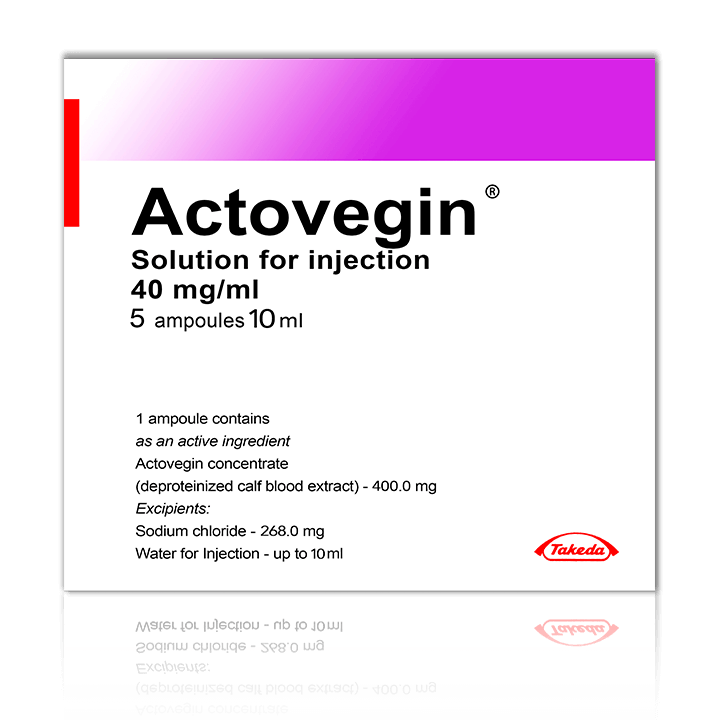Actovegin® Instruction
International Non-Proprietary Name (INN): deproteinized hemoderivative of calf blood
Dosage form: injectable solution
Structure
In a 5 ml ampoule:
Active ingredient: Actovegin® (deproteinized hemoderivative of calf blood) 200 mg;
Excipients: water for injection, up to 5 ml. The Actovegin® concentrate contains sodium chloride in the form of sodium and chlorine ions which are part of deproteinized hemoderivative of calf blood. Sodium chloride is not added and is not removed during the production of the concentrate. The concentration of sodium chloride is about 134 mg (in a 5 ml ampoule).
Description
Clear yellowish solution.
Pharmacological classification: antioxidant
ATC code: B06AB
Pharmacological action: tissue regeneration stimulator

Pharmacodynamics
Actovegin® is an antihypoxic, which offers three kinds of effects: metabolic, neuroprotective, and microcirculatory. Actovegin® increases absorption and utilization of oxygen; the phosphorylated oligosaccharides used in creating inositol have a positive impact on utilization and transport of glucose, which leads to improved cellular metabolism and a lowering of lactate formation in the presence of ischemia. The neuroprotective effect of the drug is attributed to several mechanisms.
Actovegin® inhibits the development of apoptosis induced by the beta-amyloid peptide (Aβ25-35). Actovegin® modulates the nuclear factor kappa-light-chain-enhancer of activated B cells (NF-kB), a protein complex that plays an important role in regulating apoptosis processes and inflammation in the central and peripheral nervous systems.
Another mechanism of action is connected to nuclear poly (ADP-ribose) polymerase (PARP). PARP is vital to the detection and repair of single-chain DNA. Nevertheless, too much activation of this enzyme may lead to cell death in the presence of certain conditions such as cerebrovascular disease and diabetic polyneuropathy. Actovegin® inhibits the activity of PARP, which leads to functional and morphological improvement of the central nervous system. The therapeutic effects of Actovegin®, which act on processes of microcirculation and the endothelium, are an increase in the speed of capillary blood flow, a decrease in pericapillary space, a decrease in the myogenic tone of the precapillary arterioles and capillary sphincters, a decrease in the degree of blood flow with an improved circulation of blood in the capillary bed, as well as stimulation of endothelial nitric oxide synthase function, which affects the microcirculatory bed. Over the course of various studies, it has been established that the onset of Actovegin® occurs no later than 30 minutes of taking the drug. The maximum effect is observed after 3 hours of parenteral consumption and 2–6 hours after oral consumption of the drug.
Pharmacokinetics
Pharmacokinetic methods can not be applied to study the pharmacokinetic properties of Actovegin®, as the drug is composed only of physiological components, found naturally in the body.
Intended uses
As part of complex therapy:
- symptomatic treatment of cognitive impairment, including post-stroke cognitive impairments as well as dementia;
- symptomatic treatment of peripheral circulatory disorders and related complications;
- symptomatic treatment of diabetic neuropathy.
Contraindications
- hypersensitivity to Actovegin® and analogous drugs or their excipients;
- decompensated heart failure, pulmonary edema, oliguria, anuria, water retention;
- children under 18 years of age.
Dosage and administration
Intra-arterial, intravenous, intramuscular. The drug can also be added to a solution for infusions.
Depending on the degree of clinical severity, treatment calls for 10–29 ml intravenous or intra-arterial injections daily. Further treatment should be 5 ml of intravenous or intra-arterial slow injections (daily or several times a week). For infusions of 10 to 50 ml of the drug, use 200–300 ml of base solution (isotonic solution of sodium chloride or 5% glucose solution). The speed of infusion should be around 2 ml/minute.
For intramuscular injection, use no more than 5 ml of the drug. Inject slowly, as the solution is hypertonic.
Post-stroke cognitive impairments
During the acute period following ischemic stroke, starting from day 5–7, administer Actovegin® at 2000 mg per day as an intravenous drip of up to 20 infusions, switching to the tablet form of the drug at 2 tablets 3 times a day (1200 mg/day). The total duration of treatment is 6 months.
Dementia
2000 mg per day as an intravenous drip for 4 weeks.
Peripheral circulatory disorders and related complications
800–2000 mg per day as an intra-arterial or intravenous drip. The total duration of treatment is 4 weeks.
Diabetic Neuropathy
2000 mg per day as an intravenous drip of 20 infusions, switching to the tablet form of the drug at 3 tablets, 3 times a day (1800 mg/day). The total duration of treatment is 4-5 months.
Side effects
Immune system complications
Rare: Allergic reaction (drug-induced fever, symptoms of shock).
Skin and subcutaneous complications
Rare: Hives, sudden redness.
Musculoskeletal and connective tissue complications
Not known: Myalgia.
Overdose
According to data collected during preclinical trials, Actovegin® is not toxic even in doses 30–40 times larger than the recommended doses. There have been no reported cases of Actovegin® overdose.
Interaction with other drugs
Currently unknown.
Pregnancy and lactation
The use of Actovegin in pregnancy is permissible only if the benefit exceeds the potential risk (!) to the fetus, and strictly upon doctor’s indications.
Special Instructions
Parenteral application of the drug must be performed in sterile conditions. Due to the possibility of anaphylaxis, it is recommended to perform a trial injection (test for hypersensitivity).
Do not use an opaque solution or a solution containing particles.
After opening an ampoule, do not store any leftover solution.
Terms of release from pharmacy
Without prescription.
Storage conditions
Store in a dry dark place at temperatures no higher than 25°C. Keep out of reach of children.
Shelf life
3 years. Do not use beyond the expiration date printed on the package.
Manufacturer
Takeda Pharmaceutical, Austria/Russia. https://www.takeda.com/